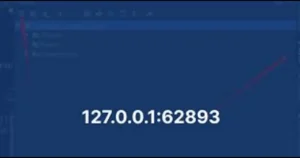Information
127.0.0.1:62893: How It Works, Its Benefits, and Top Fixing Tips

The world of networking and computer systems is often filled with complex terminology and concepts that may seem daunting at first glance. Among these, the term “127.0.0.1:62893” stands out as both technical and intriguing. To unravel this, one must understand its components—what it represents, how it works, the benefits it offers, and the steps you can take to fix any issues that might arise. This article takes you on a comprehensive journey through these aspects, ensuring clarity and practical insights.
Understanding 127.0.0.1:62893
To grasp the meaning of “127.0.0.1:62893,” let us break it down into its fundamental components. First, we have 127.0.0.1, which is the loopback IP address in networking. Often referred to as “localhost,” this IP address is used by a computer to communicate with itself. It’s a critical part of testing and development in software and networking systems because it ensures that applications can function correctly on the same device without external network dependencies.
The second part, 62893, is a port number. Ports are endpoints in networking that enable data to flow between devices and applications. Port 62893 is a randomly assigned number in the ephemeral port range, typically used by applications for temporary connections. Together, 127.0.0.1:62893 represents a local connection established by an application running on the same computer for communication purposes.
This pairing of an IP address and a port number is known as a socket. Sockets are foundational to many modern applications, allowing seamless data exchange between programs on the same machine or across a network. Understanding how this specific socket works provides insight into its significance in computing.

How 127.0.0.1:62893 Works
At its core, 127.0.0.1:62893 operates as a private communication channel within a device. When a program or application initializes communication using this address and port, the operating system manages the interaction to ensure efficient and secure data transfer. Here is a closer look at how this process unfolds:
- Initialization: When an application starts and needs to communicate with itself or another local service, it creates a socket. The socket binds to 127.0.0.1 (localhost) and an available port, such as 62893.
- Request Handling: The application sends data packets to the localhost IP and the specified port. This could involve transferring configurations, executing test queries, or simulating external communications within the local environment.
- Loopback Mechanism: The loopback interface ensures that the packets are redirected back to the originating device, allowing the application to process its data without involving external networks. This mechanism is highly efficient and secure since no data leaves the system.
- Application Response: After processing the data, the application responds through the same socket, completing the loop of communication.
This mechanism is particularly useful in scenarios such as application testing, inter-process communication, and debugging, where isolating the interaction from external networks is crucial.
Benefits of Using 127.0.0.1:62893
The use of 127.0.0.1:62893 offers numerous advantages, especially for developers, network administrators, and IT professionals. Here are some of its key benefits:
1. Enhanced Security
When data transmission is limited to the localhost, it never traverses external networks. This isolation eliminates risks associated with data interception or unauthorized access by external entities. Sensitive operations, such as testing database queries or configuring APIs, can be performed securely.
2. Improved Testing Environments
For software developers, the ability to test applications in a controlled environment is invaluable. By using 127.0.0.1:62893, developers can simulate various network conditions and verify application functionality without relying on external resources. This ensures faster development cycles and reduces dependencies on live servers.
3. Reduced Latency
The loopback interface minimizes latency since data packets do not need to traverse physical network layers. This ensures rapid communication between processes, making it ideal for real-time applications such as gaming, financial simulations, and multimedia processing.
4. Simplified Debugging
Debugging applications is far more efficient when interactions are confined to localhost. Developers can isolate issues without interference from external variables such as internet connectivity or firewall settings. This focused approach leads to quicker problem resolution.
5. Cost Efficiency
Using 127.0.0.1:62893 reduces dependency on external servers or cloud resources during the development phase. This results in significant cost savings, especially for startups and small businesses that need to optimize resource utilization.
Common Issues and Fixing Tips
Despite its utility, you might encounter issues when using 127.0.0.1:62893. Below are some of the most common problems and effective troubleshooting tips:
Problem 1: Connection Refused
This error typically occurs when an application tries to connect to 127.0.0.1:62893, but no process is listening on that port.
Fix:
- Verify that the application or service using this port is running.
- Use tools like netstat or ss to check active connections and confirm that the port is bound to 127.0.0.1.
- Ensure no firewall rules are blocking the localhost communication.
Problem 2: Port Already in Use
If another application is already using port 62893, your application might fail to bind to it.
Fix:
- Identify the process using the port with commands like lsof -i :62893.
- Terminate or reconfigure the conflicting process to use a different port.
- Configure your application to select an available port dynamically.
Problem 3: Misconfigured Hosts File
An incorrectly configured hosts file can prevent the system from resolving 127.0.0.1 to localhost.
Fix:
- Open the hosts file (usually located at /etc/hosts on Unix systems or C:\Windows\System32\drivers\etc\hosts on Windows).
- Ensure the file contains the entry 127.0.0.1 localhost.
Problem 4: Application Timeout
If the application does not respond within the expected time, it may trigger a timeout error.
Fix:
- Optimize the application’s processing logic to reduce response time.
- Increase the timeout settings in the client application to accommodate slower responses during testing.
Problem 5: Socket Errors
Socket-related errors can occur due to improper initialization or termination of connections.
Fix:
- Ensure proper handling of socket lifecycles within your application code.
- Close unused sockets to free resources and prevent conflicts.

Best Practices When Working with 127.0.0.1:62893
To make the most of 127.0.0.1:62893, consider adopting the following best practices:
- Use Unique Ports: Avoid conflicts by dynamically assigning ports within the ephemeral range for testing purposes.
- Implement Logging: Maintain detailed logs of socket activities to simplify debugging and performance monitoring.
- Secure Configurations: Limit permissions and access to critical services using localhost to prevent unauthorized modifications.
- Leverage Automation Tools: Automate testing and monitoring workflows using tools like Postman or JMeter for better efficiency.
- Validate Application States: Use health checks to verify that services bound to localhost are running as expected.
Use Cases for 127.0.0.1:62893
The versatility of 127.0.0.1:62893 lends itself to numerous applications across different domains. Below are a few noteworthy use cases:
- Database Development: Test SQL queries and database configurations locally before deploying to production environments.
- Web Development: Simulate server-client interactions using localhost to verify API endpoints and front-end integrations.
- Game Development: Use loopback connections for multiplayer testing to ensure real-time communication between game instances.
- DevOps Pipelines: Test CI/CD pipelines by simulating network calls without relying on external infrastructure.
Conclusion
127.0.0.1:62893 represents more than just a technical detail; it embodies a vital mechanism for local communication in modern computing. By understanding its workings, leveraging its benefits, and addressing potential issues effectively, developers and IT professionals can optimize their workflows and enhance productivity. Whether you’re building applications, troubleshooting errors, or exploring innovative solutions, mastering this fundamental concept is a step toward achieving excellence in technology.
-

 Blog8 months ago
Blog8 months agoDiscover The World Of Movies With Mkvcinemas.com
-

 Biography9 months ago
Biography9 months agoMadeline Argy: Age, Height, and Family Background Revealed
-

 Tech9 months ago
Tech9 months agoSimpCityForum: One of the Most Interesting Online Communities
-

 Biography9 months ago
Biography9 months agoCelebrityMeet Christina Erika Carandini Lee?: All You Need To Know
-

 Biography8 months ago
Biography8 months agoMary Marquardt: The Woman Behind Harrison Ford’s Rise
-

 Biography9 months ago
Biography9 months agoHow Old Is SZA Daughter? Discover SZA Daughter’s Age, Name, and More
-

 Crypto Currency9 months ago
Crypto Currency9 months ago5starsstocks .com: How It’s Useful and Helpful
-

 Blog9 months ago
Blog9 months agoWhat is FilthyGrid? Exploring the World of FilthyGrid
-

 Health & Fitness9 months ago
Health & Fitness9 months agoWhat Has Kiolopobgofit in It? Exploring the Enigmatic Concept
-

 Biography9 months ago
Biography9 months agoChevy Chase Net Worth, Bio, Age, Height, Wife & Family

